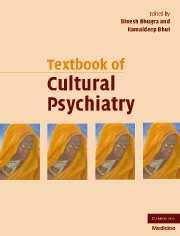Book contents
- Frontmatter
- Contents
- Contributors
- Foreword
- Preface
- Part I Theoretical background
- 1 Cultural psychiatry in historical perspective
- 2 Anthropology and psychiatry: the contemporary convergence
- 3 Suicide, violence and culture
- 4 Psychology and cultural psychiatry
- 5 Spirituality and cultural psychiatry
- 6 Culture, ethnicity and biological psychiatry
- 7 Ethnic inequalities and cultural capability framework in mental healthcare
- Part II Culture and mental health
- Part III Culture and mental disorders
- Part IV Theoretical aspects of management
- Part V Management with special groups
- Part VI Cultural research and training
- Cultural psychiatry: the past and the future
- Index
- References
4 - Psychology and cultural psychiatry
from Part I - Theoretical background
Published online by Cambridge University Press: 11 August 2009
- Frontmatter
- Contents
- Contributors
- Foreword
- Preface
- Part I Theoretical background
- 1 Cultural psychiatry in historical perspective
- 2 Anthropology and psychiatry: the contemporary convergence
- 3 Suicide, violence and culture
- 4 Psychology and cultural psychiatry
- 5 Spirituality and cultural psychiatry
- 6 Culture, ethnicity and biological psychiatry
- 7 Ethnic inequalities and cultural capability framework in mental healthcare
- Part II Culture and mental health
- Part III Culture and mental disorders
- Part IV Theoretical aspects of management
- Part V Management with special groups
- Part VI Cultural research and training
- Cultural psychiatry: the past and the future
- Index
- References
Summary
EDITORS' INTRODUCTION
Psychology as a discipline focuses on the study of human behaviour in different settings; its relationship with psychiatry in general has been one of healthy tension, even though biopsychosocial models of aetiology and management emphasise psychological factors as one of the three prongs along with biological and social factors. Psychology emerged in the Eurocentric tradition, even though mental illnesses and abnormal behaviours had been described for centuries across cultures. The relationship between psychology and cultural psychiatry has been infected by mutual suspicion. The suspicion is due to several reasons, including political imperatives on both sides. Cross-cultural psychology as a discipline aims to provide localized cultural perspective and comparative cultural perspectives, and is a relatively recent development. Psychology focuses on both the individual and their development, and the consequences in response to their actions.
MacLachlan and McGee emphasize that psychology focuses on the smallest unit in society – the individual – and on how the individual's life experiences and characteristics influence health and the experience is seen as central to but not independent of cultural factors. The relationship between medical anthropology, medical sociology and clinical/health psychology is of great interest in trying to make sense of the practice of cultural psychiatry. Describing the development of Problem Portrait Technique, which seeks to convey a likeness of a person's presenting problems through both words and images, is one way of trying to understand a person's inner experience. Some of these questions are fairly similar to questions asked while exploring explanatory models, and this technique gives the clinician a complete outline of causal factors that a more conventional approach to assessment may have overlooked.
- Type
- Chapter
- Information
- Textbook of Cultural Psychiatry , pp. 43 - 58Publisher: Cambridge University PressPrint publication year: 2007



